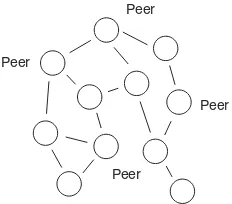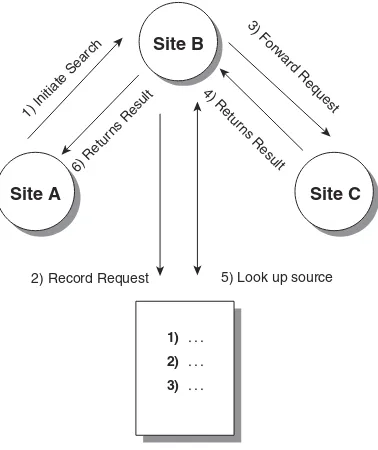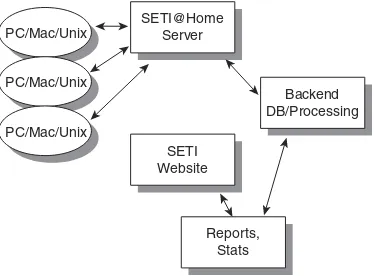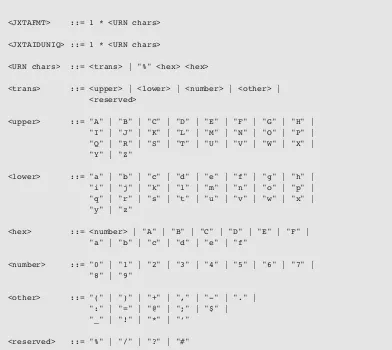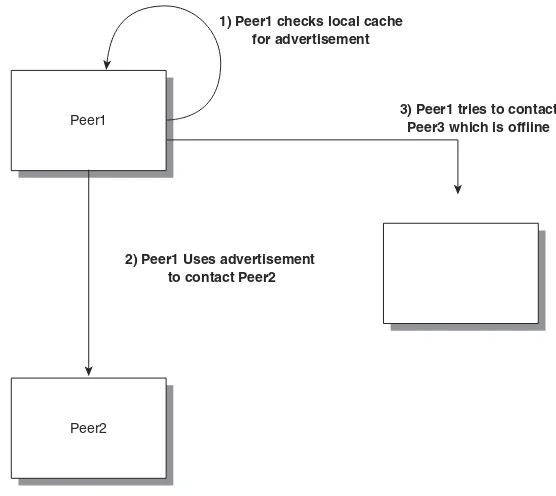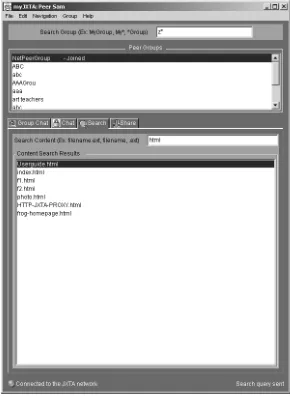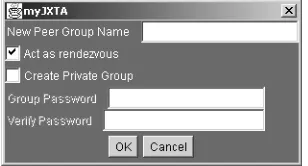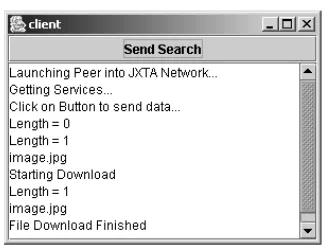Wiley Publishing, Inc.
Mastering JXTA
Building Java Peer-to-Peer Applications
Wiley Publishing, Inc.
Mastering JXTA
Building Java Peer-to-Peer Applications
Managing Editor: John Atkins Compositor: Gina Rexrode Book Packaging: Ryan Publishing Group, Inc. Technical Editor: Stan Ng
Designations used by companies to distinguish their products are often claimed as trademarks. In all instances where Wiley Publishing, Inc., is aware of a claim, the product names appear in initial capital orALL CAPITAL LETTERS. Readers, however, should contact the appropriate companies for more complete information regarding trademarks and registration.
This book is printed on acid-free paper. ∞
Published by Wiley Publishing, Inc., Indianapolis, Indiana
Published simultaneously in Canada.
No part of this publication may be reproduced, stored in a retrieval system, or transmitted in any form or by any means, electronic, mechanical, photocopying, recording, scanning, or otherwise, except as permitted under Section 107 or 108 of the 1976 United States Copyright Act, without either the prior written permission of the Publisher, or authorization through payment of the appropriate per-copy fee to the Copyright Clearance Center, Inc., 222 Rosewood Drive, Danvers, MA 01923, (978) 750-8400, fax (978) 750-4470. Requests to the Publisher for permission should be addressed to the Legal Department, Wiley Publishing, Inc., 10475 Crosspointe Blvd., Indianapolis, IN 46256, (317) 3447, fax (317) 572-4447, email: permcoordinator@wiley.com.
Limit of Liability/Disclaimer of Warranty: While the publisher and author have used their best efforts in preparing this book, they make no representations or warranties with respect to the accuracy or com-pleteness of the contents of this book and specifically disclaim any implied warranties of mer-chantability or fitness for a particular purpose. No warranty may be created or extended by sales representatives or written sales materials. The advice and strategies contained herein may not be suit-able for your situation. You should consult with a professional where appropriate. Neither the pub-lisher nor author shall be liable for any loss of profit or any other commercial damages, including but not limited to special, incidental, consequential, or other damages.
For general information on our other products and services please contact our Customer Care Depart-ment within the United States at (800) 762-2974, outside the United States at (317) 572-3993 or fax (317) 572-4002.
Wiley also publishes its books in a variety of electronic formats. Some content that appears in print may not be available in electronic books.
Library of Congress Cataloging-in-Publication Data: ISBN: 0-471-25084-8
Acknowledgments xix
About the Author xxi
Introduction xxiii
Part I
JXTA Overview
Chapter 1 Introduction to Peer-to-Peer 1
What Is a Peer-to-Peer Architecture? 2
The Hierarchical Topology 3
The Ring Topology 4
The Client-Server, or Centralized, Topology 4
The Decentralized Topology 4
The Hybrid Topology 5
Examples of Peer-to-Peer Systems 6
Napster 6 Gnutella 7 Morpheus/KaZaA 8 Usenet 9
Instant Messaging 10
Extreme Peer-to-Peer: Distributed Computational Engines 10 Warnings 11
Workplace Policies 11
Intellectual Property 11
Bandwidth Costs 12
Security 12 Summary 13
Chapter 2 An Overview of JXTA 15
The JXTA Architecture 17
The Core Layer 17
The Services Layer 18
The Application Layer 18
Major JXTA Technologies 19
IDs 19
The Peer 24
Peer Groups 25
Advertisements 26 Modules 27
Transport Mechanisms and Pipes 28
Services 30 Discovery 31
Handling Private Networks 36
Summary 38
vii
Chapter 3 JXTA Shell 39
Executing the Shell 39
Shell Commands 40
Writing New Shell Commands 53
Summary 53
Chapter 4 Using myJXTA 55
Downloading myJXTA 56
Executing myJXTA 56
Executing myJXTA for the First Time 56
myJXTA Window 59
Summary 72
Chapter 5 JXTA Advertisements 73
Core Advertisements 73
An XML-Based Format 74
Peer Advertisements 75
Peer Group Advertisements 79
Module Class Advertisements 80
Module Specification Advertisements 81
Module Implementation Advertisements 83
Pipe Advertisements 89
Displaying an Advertisement 90
Creating an Advertisement 91
Building an Advertisement from Scratch 92
Summary 93
Part II
JXTA Protocols
Chapter 6 Peer Discovery Protocol 95
PDP Protocol Overview 96
Java Binding of the PDP 99
Discovery Service 99
Summary 108
Chapter 7 Peer Resolver Protocol 109
An Overview of the PRP 109
Handler Naming 110
Resolver Query Messages 111
Resolver Response Messages 112
Java Binding of the PRP 115
Building a Handler 116
Getting the Resolver and Registering a Handler 120
Sending a Query 120
Chapter 8 Peer Information Protocol 123
An Overview of the PIP 123
PIP Query Messages 124
PIP Response Messages 124
Java Binding of the PIP 126
Requesting Peer Information 127
Building a Listener 127
Viewing the Information Returned 128
Summary 129
Chapter 9 Peer Endpoint Protocol 131
An Overview of the Peer Endpoint Protocol 131
Endpoint Service 132
Sending a Message 133
Endpoint Protocols 133
Java Binding of the Peer Endpoint Protocol 134 Summary 136
Chapter 10 Pipe Binding Protocol 137
Overview of the Pipe Binding Protocol 137
Pipe Advertisements 138
Pipe Binding Query Messages 138
Java Binding 140
Creating a Pipe 141
Receiving Information 142
Building the Pipe 143
Advertising the Pipe 143
Discovering an Input Pipe 144
Summary 144
Chapter 11 Rendezvous Protocol 145
Rendezvous Advertisements 146
Message Propagation 146
The Java Binding 147
Dynamic Rendezvous Service Implementation 147
Finding Rendezvous Peers Dynamically 148
Connecting to Rendezvous Peers 148
Disconnecting from a Rendezvous Peer 149
Summary 150
Chapter 12 Developing a JXTA Application 151
The Basic Structure for JXTA Applications 152
Connecting to the JXTA Network 153
Viewing Peer Group Information 154
Viewing Peer Group Advertisement 155
Building a Peer to Offer Services 157
Obtaining Group Services 162
Building and Publishing the Module Class Advertisement 163
Building the Pipe Advertisement 164
Building and Publishing the Module Specification Advertisement 166
Waiting for Messages 167
Putting It All Together 168
Building a Peer for Using Services 169
Code for the Receiver Peer 170
Getting Services 175
Finding the Advertisement through Discovery 175
Building an Output Pipe 176
Sending a Message through a Pipe 177
Application Basics 177
Creating a New Peer Group 178
Creating a Peer Group ID 178
Creating a Module Implementation Advertisement 179
Creating a Group Advertisement 180
Creating a New Peer Group 180
A Peer that Discovers and Joins a New Peer Group 187
Creating a Secure Peer Group 192
Using a Membership Service Implementation 192 Changing the Default Class Implementation Advertisement 193
Code for a Secure Peer Group 194
A Secure Peer Group Advertisement 201
Becoming Authenticated 202
New Class Implementation Advertisement Details 204
Peer Group Advertisement Details 205
authenticateMe() Method Details 206
Client for the Secure Peer Group 207
Summary 207
Chapter 13 JXTA Pipes 209
Publishing and Discovering Pipes 210
Publishing 210 Discovery 210
Unicast Pipes 214
Unicast Pipes on a Local Peer 214
Remote Peers 216
UnicastSecure Pipes 218
Propagate Pipes 218
Bidirectional Pipes 225
The Bidirectional Pipe Code 225
The Bidirectional Pipe Discovery Code 229
Reliable Pipes 234
Sender Code 237
The Receiver Code 242
Contents xi
Part III
JXTA Implementation
Chapter 14 Content Sharing and the Content Management Service (CMS) 243
Overview of the CMS 243
Implementing the CMS in Peers 245
Initializing the CMS 250
Sharing Content 250
Viewing the Shared Content List 251
Searching For and Getting Content 251
Summary 254
Chapter 15 Implementing Security 255
JXTA Security Toolkit 255
Building Keys 256
Secure Membership Service 263
Building a New Membership Service 264
Changing the Peer Group Creator Code 275
Secure Transport 277
JxtaUnicastSecure Pipes 277
Separately Encrypted Data 279
Summary 300
Chapter 16 Peer Monitoring and Metering 301
Finding Peers in a Group 301
Building the Peer Discovery Listener 301
Interpreting Events 302
The Discovery Code 304
Local Peers versus Remote Peers 305
Obtaining Information about a Peer 307
A Sample Application for Discovering Peers 309
Explaining the Code 315
Code Output 316
Summary 317
Chapter 17 Configuring NAT and Firewall Peers 319
The JXTA Network Topology 319
Running a Peer Behind a Firewall/NAT 320
Communication Peer Configuration 320
Gateway Configuration 323
The Discovery Peer Configuration 324
Using the Configurator’s Debug Option 326
Building a Router/Rendezvous Peer 327
Chapter 18 Using Endpoints for Low-Level Communication 331
The Endpoint Service 331
Code for the Endpoint Receiving Peer 334
Code for the Endpoint Sending Peer 337
Summary 341
Chapter 19 Building a Generic Framework for Distributed Computing 343
Master Code 344
Worker Code 349
Setup 355 Work 355
Computational Code 356
Summary 358
Chapter 20 Building an Encrypted, Highly Available Storage System 359
System Architecture 359
Our Example 361
Database Schema 362
Message Schema 362
Executing the System 363
DatabasePeer 366
DatabasePeer Connectivity 372
Setup 374
Publishing a Data Input Pipe 375
Publishing a Query Bidirectional Pipe 375
Processing Input 375
BusinessPeer 377 Setup 383 Discovery 384
Processing Input 384
GatheringPeers 385 ClientPeer 386 Setup 393
Pipe Discovery 394
The Query Request 395
The Image Request 395
Summary 396
Part IV
JXTA Reference
Appendix A Installing JXTA and Compiling JXTA Applications 397
Installing JXTA 397
Easy Install 397
Installing on a Linux System 399
JXTA Libraries 399
Stable Builds 400
Daily Builds 401
Compiling the Examples 401
Windows 401 Linux 402
Running the Examples 402
Windows 402 Linux 403
JBuilder Compiling and Execution 403
Adding a New JBuilder Project 404
Appendix B JXTA API 407
Class Advertisement 407
Field Summary 408
Constructor Summary 408
Method Summary 408
Example 408
Class AdvertisementFactory 408
Method Summary 408
Class AuthenticationCredential 409
Constructor Summary 410
Method Summary 410
Example 410
Class Codat 411
Field Summary 411
Constructor Summary 411
Method Summary 411
Example 411
Class CodatID 412
Constructor Summary 412
Method Summary 412
Example 412
Interface Credential 412
Method Summary 412
Class DiscoveryEvent 413
Constructor Summary 413
Method Summary 413
Example 413
Interface DiscoveryListener 413
Method Summary 414
Example 414
Class DiscoveryQueryMsg 414
Field Summary 414
Constructor Summary 414
Method Summary 414
Class DiscoveryResponseMsg 415
Field Summary 415
Constructor Summary 415
Method Summary 415
Example 416
Interface DiscoveryService 416
Field Summary 416
Method Summary 417
Example 418
Interface Document 418
Method Summary 418
Example 418
Interface Element 419
Method Summary 419
Example 419
Interface EndpointAddress 419
Method Summary 419
Example 420
Class EndpointAdvertisement 420
Constructor Summary 420
Method Summary 420
Interface EndpointFilterListener 421
Method Summary 421
Interface EndpointProtocol 421
Method Summary 421
Example 422
Interface EndpointService 422
Method Summary 422
Example 423
Interface GenericResolver 424
Method Summary 424
Class ID 424
Field Summary 424
Constructor Summary 424
Method Summary 425
Class IDFactory 425
Method Summary 425
Example 426
Interface InputPipe 426
Method Summary 426
Example 426
Class JxtaError 427
Field Summary 427
Constructor Summary 427
Class MembershipService 427
Constructor Summary 427
Method Summary 427
Example 428
Interface Message 428
Method Summary 429
Example 430
Class MessageElement 430
Constructor Summary 430
Method Summary 430
Example 431
Class MimeMediaType 431
Constructor Summary 431
Method Summary 432
Example 432
Class ModuleClassAdvertisement 432
Constructor Summary 433
Method Summary 433
Example 433
Class ModuleClassID 434
Constructor Summary 434
Method Summary 434
Class ModuleImplAdvertisment 434
Constructor Summary 434
Method Summary 434
Example 435
Class ModuleSpecAdvertisement 435
Constructor Summary 436
Method Summary 436
Example 437
Class ModuleSpecID 437
Constructor Summary 437
Method Summary 437
Example 437
Interface OutputPipe 438
Method Summary 438
Example 438
Class PeerAdvertisement 438
Constructor Summary 438
Method Summary 438
Example 439
Interface PeerGroup 439
Constructor Summary 440
Method Summary 440
Class PeerGroupAdvertisement 442
Constructor Summary 442
Method Summary 442
Example 443
Class PeerGroupFactory 443
Constructor Summary 443
Method Summary 443
Example 444
Class PeerGroupID 444
Field Summary 444
Constructor Summary 444
Example 444
Class PeerID 445
Constructor Summary 445
Method Summary 445
Example 445
Class PeerInfoEvent 445
Constructor Summary 445
Method Summary 445
Example 446
Interface PeerInfoListener 446
Method Summary 446
Class PeerInfoQueryMessage 446
Constructor Summary 446
Method Summary 446
Example 447
Class PeerInfoResponseMessage 447
Constructor Summary 447
Method Summary 447
Class PipeAdvertisement 448
Field Summary 448
Constructor Summary 449
Method Summary 449
Example 449
Class PipeID 450
Constructor Summary 450
Method Summary 450
Example 450
Class PipeMsgEvent 450
Constructor Summary 450
Method Summary 451
Example 451
Interface PipeMsgListener 451
Interface PipeService 452
Field Summary 452
Method Summary 452
Example 452
Interface QueryHandler 453
Method Summary 453
Interface RendezvousListener 453
Method Summary 453
Interface RendezVousService 453
Method Summary 453
Class ResolverResponseMsg 455
Field Summary 455
Constructor Summary 455
Method Summary 455
Interface ResolverService 455
Method Summary 456
Interface StructuredDocument 456
Method Summary 456
Class StructuredDocumentFactory 456
Method Summary 456
Example 457
Interface StructuredTextDocument 457
Method Summary 457
Example 458
Interface TextDocument 458
Method Summary 458
Interface TextElement 458
Method Summary 458
Example 458
Appendix C Current Add-on JXTA Services 459
Appendix D Latest JXTA Projects 463
Appendix E JXTA Resources 467
Mailing Lists 467
Discuss Mailing List 467
Announce Mailing List 467
Dev Mailing List 468
User Mailing List 468
JXTA Tutorials 468
Appendix F JXTA Bindings 469 Java 469
Java ME (JXME) 470
jxta-c 471 jxtaPerl 471 jxtapy 472 jxtaruby 472 pocketJXTA 473
Appendix G Other Peer-to-Peer Implementations and Toolkits 475
IBM BabbleNet 475
Intel 476
Microsoft .NET and P2P 476
The Peer-to-Peer Trusted Library 476
The Bluetooth P2P Toolkit 477
Other Tools 477
xix
C O N T E N T S
xix
I would like to acknowledge several folks. First, Tim Ryan for
every-thing he does to support the writing of this book and his friendship.
Sec-ond, Liz Welch for her diligent editing of this manuscript. Third, Stan Ng
for his technical editing and keeping me straight on the use of the JXTA
software.
xxi
C O N T E N T S
Joseph D. Gradecki
is a software engineer at Comprehensive Software
Systems, where he works on its SABIL product, an enterprise-level
securities processing system. He has built numerous dynamic enterprise
applications using Java, C++, servlets, JSPs, Resin, MySQL, BroadVision,
XML, and other technologies.
Joe has also built many P2P distributed computing systems in a variety of
languages, including Java/JXTA, C/C++, and Linda. He holds Bachelor’s
and Master’s degrees in Computer Science, and is currently pursuing a
Ph.D. in Computer Science. Joe also regularly teaches Java and OOP
courses at Colorado Technical University.
xxi
M
any of us tend to think of the Internet, and most other networks, as inherently client-server systems. Web developers spend a lot of time building powerful sites that serve information and services to the thou-sands of browser clients that visit them. But peer-to-peer (P2P) applications like KaZaA, Napster, and SETI have demonstrated the true power of the Inter-net: the millions of information stores—common PCs—sitting idle on desks around the world. Peer-to-peer technologies harness the CPUs and storage devices of these PCs to produce huge data stores, communications systems, and processing engines.Due to a lack of standards and toolkits, early P2P application developers spent much of their time reinventing the wheel—building the same system “plumb-ing” for each new app they wrote. Developers at Sun created the JXTA specifi-cation to solve this problem. The specifispecifi-cation is a basic building block from which developers can produce applications that
■■ Allow sharing of resources between peers without a central server ■■ Use idle cycles of desktop machines for solving complex problems ■■ Expose Web services to be used by other peers
What’s In This Book
This book contains a complete discussion of the latest JXTA specification and the Java binding. As with any new technology, a number of components form
Introduction
the foundation of the specification. This book explains each of the core com-ponents and protocols of JXTA, and includes comprehensive examples to back up the concepts. Some of the concepts discussed in this book are
Peers—An application, executing on a computer, that has the ability to communicate with similar peer applications
Peer groups—A logical grouping of peers
Modules—Code that is made available by a peer or peer group for use by another peer or peer group.
Pipes—Communication channels created between peers
Services—Predefined functionality that can be utilized by peers Advertisements—XML-based messages used to publish information between peers
Following a complete discussion of the specification, this book provides many code examples and full P2P applications written in Java. After reading Master-ing JXTA, you will have a foundation in P2P programming and, more impor-tant, you will have several examples and full-blown applications to use as a springboard for your own creations. One of the major examples in this book builds a framework for distributed computations using JXTA. Using a generic work class, you can build P2P applications that will pass computational work to be done to peers and accumulate the results. Another example will show you how to build a comprehensive, three-tier storage system; this system allows data to be sent from client peers to business peers to database peers. The data-base peer connects to a MySQL datadata-base to store the data.
One of the major goals of this book is demonstrating how to develop P2P cations by stepping you through the process of building a comprehensive appli-cation framework that you can reuse to develop your own appliappli-cations. You can find the code in this book at www.wiley.com/compbooks/gradecki. The code for each chapter is located in a separate file so that you can quickly find what you need. The JXTA Java Reference Implementation can be found at www.jxta.org. You will also need the Java SDK, which you can find at www.javasoft.com.
Who Should Read This Book
If you want to know how to build sophisticated, Java-based, peer-to-peer appli-cations, then this book is for you.
Book Organization
This book is organized into three parts. Part I is a comprehensive overview of P2P, the JXTA specification, and the JXTA architecture and its components. Part II discusses the JXTA protocols, which are the core of the specification; you must understand the protocols in order to build robust P2P applications using a binding language. Finally, Part III takes all of the concepts learned in Parts I and II and applies them to many small examples and two large applica-tions: a distributed computational engine and a robust storage service. Let’s take a look at each of the chapters making up the three parts of the book.
Part I: JXTA Overview
Chapter 1: Introduction to Peer-to-Peer
This chapter provides the uninitiated with a comprehensive overview of what P2P is, where it came from, and how it’s been used. We look to the past in order to understand that the concepts of a P2P network are really quite old. Next, we examine the various architectures that can be created when a P2P system is developed. Finally, we look into the more common P2P systems—such as Usenet, Napster, Gnutella, Instant Messaging, and distributed.net—to under-stand what you can do with peer-to-peer.
Chapter 2: An Overview of JXTA
This chapter is the fundamental chapter in the book. We describe the JXTA sys-tem, starting with its short history. Then we examine the JXTA architecture, which consists of three layers: the core layer, the services layer, and the appli-cation layer. We describe each of the layers in detail, and explain the compo-nents needed in each layer. The layers rely on several JXTA technologies, which are described next. These technologies are
■■ Peer ■■ Group
■■ Advertisement ■■ Protocols ■■ Pipes
■■ Services
■■ Rendezvous peers
Finally, we include an overview of how you can use JXTA in networks that have firewalls and peers that use a NAT address. Because XML is used through-out JXTA, an overview of XML is also provided for those who are new to that technology.
Chapter 3: JXTA Shell
One of the easiest ways to experience the JXTA system is through the JXTA shell. The JXTA shell is an interactive application that allows a command-line interface to the JXTA network; it is modeled after a Unix shell, and includes a number of commands for manipulating the shell presence on the network. Some of the commands we discuss are whoami, peers, env, share, and search, among many others. We provide a comprehensive overview of the shell and how to use it on the network. We cover all of the commands in the shell, along with helpful examples, and conclude with a discussion on writing shell scripts and user-defined classes.
Chapter 4: Using myJXTA
In order to further explain the code necessary to write JXTA P2P applications, this chapter focuses on the InstantP2P application, which you can download from the JXTA project web site. We examine major features of this application, including
■■ Chatting with InstantP2P in a group ■■ Using one-to-one chatting
■■ Searching for files in a group ■■ Sharing your own files
We discuss each of these features as well as the code used to implement them.
Chapter 5: JXTA Advertisements
Part II: JXTA Protocols
Chapter 6: Peer Discovery Protocol
This chapter provides a detailed view of the Peer Discovery Protocol (PDP), which is used for all discovery of advertisements from peers. A peer uses the PDP for resource queries, and will receive zero or more responses. In this chap-ter, we describe the messages received from a query as well as how to perform a PDP query. In addition, we briefly discuss how the protocol was implemented, and the features available for those peers that want to build and use their own discovery mechanism.
Chapter 7: Peer Resolver Protocol
The Peer Resolver Protocol is a generic query protocol designed to allow peers to query either specific peers or peers within a peer group. In this chapter, we examine the protocol specification and how it is used to implement a number of the JXTA protocols. We also cover the message formats and how to use the protocol. At the end of the chapter, you’ll find a discussion of how the protocol is implemented.
Chapter 8: Peer Information Protocol
In any peer-to-peer environment, information about peers must be readily avail-able. The Peer Information Protocol is a powerful mechanism for obtaining information about a peer once it has been discovered. In this chapter, we exam-ine the protocol. As in the other protocol chapters, we cover the query and response messages, along with specific implementation details.
Chapter 9: Peer Endpoint Protocol
The JXTA network is designed to allow for routing between peers. There are times when one peer needs to send a message to another peer and they are not “directly” connected. In these situations, a relay peer will be used. In this chap-ter, we dive into the details behind the Peer Endpoint Protocol. We cover all of the query and response messages as well as implementation details.
Chapter 10: Pipe Binding Protocol
When peers want to communicate by sending more than advertisements, a pipe is necessary. The Pipe Binding Protocol provides the details behind pipes, end-points, and transport mechanisms. In this chapter, we discuss all of these con-cepts and examine the various messages being transferred between peers.
Chapter 11: Rendezvous Protocol
The Rendezvous Protocol allows for the propagation of messages within a P2P system. In this chapter, we cover the Rendezvous Protocol, which is used by both the Peer Resolver and Pipe Binding Protocols.
Chapter 12: Developing a JXTA Application
This chapter provides the details behind building JXTA P2P applications. Using the information gathered from the first two parts of the book, this chapter guides you through the development of both command-line and GUI-based Java applications. You will learn how to build JXTA P2P applications using a simple-to-understand skeleton. We expand the skeleton to include creating and joining peer groups with both secure and non-secure membership rules.
Chapter 13: JXTA Pipes
One of the primary reasons to build a P2P system is to facilitate the transfer of information between the peers. The peers and services are made known to each other through advertisements, and information is transfer through a pipe. The concept is the same as that found in the Unix system, in which a pipe connects two commands. In this chapter, we explain the pipes used in JXTA, and illus-trate with examples.
Part III: JXTA Implementation
Chapter 14: Content Sharing and the Content Management
Service (CMS)
The Content Management Service (CMS) is a perfect example of an add-on to the JXTA network using a service. This software allows for easy sharing, access, and retrieval of all kinds of content in the JXTA networks. As you’ll learn in this chapter, by using simple commands peers can implement the CMS and instantly be able to share content with other peers.
Chapter 15: Implementing Security
Chapter 16: Peer Monitoring and Metering
As peers are developed and deployed, the issue of monitoring and metering will arise. In this chapter, each of these issues are addressed. On the topic of moni-toring, we present code that allows a P2P system to keep track of the peers in the group, when they joined the group, when they left the group, and when sud-den peer death occurs.
Chapter 17: Configuring NAT and Firewall Peers
Of particular importance to enterprise systems is how to handle firewall and Network Address Translation (NAT). In this chapter, we explain how to config-ure peers that use a NAT address and/or exist behind a firewall. We present code that you can use to build a simple peer to be used as a gateway or ren-dezvous peer.
Chapter 18: Using Endpoints for Low-level Communication
Under the high-level pipe component is a lower-level mechanism for communi-cating between peers. Endpoints represent portals into and out of individual peers and can be used as a low-level communication channel. This chapter will explore endpoints and present code for using them in peers.
Chapter 19: Building a Generic Framework for Distributed
Computing
This chapter builds an application like SETI or distributed.net using the JXTA framework. We examine the process of building a framework system, in which computationally complex algorithms can be distributed to peers on the net-works that choose to subscribe.
Chapter 20: Building an Encrypted, High-Availability Storage
System
Imagine building an encrypted remote storage service in which clients can sign up and store vital records. In this chapter, we build such a system, and explore topics such as using replication among peers and handling integration with backend databases.
Part IV: JXTA Reference
Appendix A: Installing JXTA and Compiling JXTA Applications
Appendix A provides a guide for installing and using the JXTA system. Infor-mation covered in the appendix includes
■■ Finding JXTA
■■ Finding the ancillary installs you need ■■ Downloading the files
■■ Installing on Windows ■■ Installing on Linux ■■ Installing on Solaris
■■ Obtaining daily builds for the latest code
Appendix B: JXTA API
Appendix B provides a complete listing of the current JXTA API, along with descriptions.
Appendix C: Current Add-on JXTA Services
Since JXTA is a core technology, a number of complementary systems have been developed that can be “bolted” onto a P2P system. In this appendix, we look at some of those services and their current status.
Appendix D: Latest JXTA Projects
Anyone who has taken the time to look at the JXTA web site will find a number of projects. This chapter details the most important of those projects and how services provided by the projects can be utilized in other applications.
Appendix E: JXTA Resources
Appendix F: JXTA Bindings
Appendix F covers the current language bindings of the JXTA specification. While Java was the first, a number of other bindings have been created using most of the recent and popular languages.
Appendix G: Other Peer-to-Peer Implementations and Toolkits
In this appendix, we examine some of the other P2P implementations and toolkits. We discuss both commercial and open-source systems.
T
he early developers of ARPANET and the Internet allowed themselves to dream about a day when computers around the world would be linked together to share resources in a peer-to-peer fashion. In 1962, one of those early dreamers, J.C.R. Licklider of MIT, wrote a now-famous series of memos in which he described an “Intergalactic Network” of interconnected computers. His vision led to the creation of the Network Control Program (NCP), the first “host-host” networking protocol and the precursor to TCP/IP. The host-host concept—which we now call peer-to-peer—was crucial in devel-oping the Internet. Every computer on the network was an equal: Each com-puter could access the resources of any other comcom-puter on the network while making its own resources available. Communication among hosts was also equal: No computer was seen as a client or component of another, and all com-puters shared more-or-less equal bandwidth access to one another.Several events have conspired to change the Internet landscape from primarily peer-to-peer to the now more familiar client-server architecture. The Internet has gradually become more commercial, and corporations build firewalls around their information to control access. Millions of people “log on” to the Internet using desktop computers that cannot match the power of the servers that form the backbone of the Internet. And many popular Internet applications and services, including the World Wide Web and FTP, are based on a client-server architecture.
Introduction to Peer-to-Peer
C H A P T E R
1
In the last few years, however, peer-to-peer (P2P) technology has once again had a profound effect on the Internet and the distribution of information and resources. P2P is being aggressively hyped in the media, but there are a wide variety of opinions as to what exactly P2P is:
■■ Clay Shirky (Internet consultant, writer, and speaker) once said that “P2P is a class of applications that takes advantage of resources—storage, cycles, content, human presence—available at the edges of the Internet.” ■■ Li Gong of Sun Microsystems wrote that “The term peer-to-peer network-ing is applied to a wide range of technologies that greatly increase the uti-lization of information, bandwidth, and computing resources in the Internet. Frequently, these P2P technologies adopt a network-based com-puting style that neither excludes nor inherently depends on centralized control points.”
■■ Ed Dumbill of XML.com said, “P2P is whoever says they’re P2P.”
Right now Mr. Dumbill’s definition seems to be winning the popular vote. One of the purposes of this chapter is to help you formulate your own answer to the question, “What is P2P?” The next section begins our discussion of peer-to-peer technology with a quick review of network topologies. In the final section, we look at Napster, Morpheus, instant messaging, and Usenet from a P2P perspec-tive; and then discuss some of the legal, technical, and security issues that have arisen from the use of these and similar applications.
What Is a Peer-to-Peer Architecture?
If we take a moment to consider the Internet itself, we will see that there are millions of computers connected in the network at any given time. All of the computers are theoretically connected to one another, and information stored on any of the systems can be accessed. As a whole, the topology or layout of the computers on the Internet is a grouping of machines spread out in various loca-tions. Within each of the groups or subnets, computers will be visible to other computers on the subnet and sometimes to the outside Internet.
In most peer-to-peer systems, the division between a server and a client is blurred. The computer itself might be connected to other computers using a token-ring topology, but a peer-to-peer system might have a completely differ-ent architecture. The peers could all be communicating with a cdiffer-entral server, like Napster.
In most cases, peers will be connected to one another over the Internet using either the TCP or HTTP protocol. As you probably already know, TCP/IP is the fundamental protocol for transferring information over the Internet. The HTTP protocol is built on top of TCP/IP and allows communication between computers using port 80. HTTP is very popular for peer-to-peer systems because most organizations keep port 80 clear on their firewalls for web browser traffic.
Several network topologies can be used for connecting P2P systems. In this section, we discuss the major P2P network topologies in order to explain how information can be transmitted between peers effectively.
The Hierarchical Topology
One of the most common topologies is the hierarchy. Every time you type a website URL into your browser, you are using a system called DNS, or Domain Name Server. This system is set up in a hierarchy, with root servers at the very top levels. The hierarchy topology looks like Figure 1.1. For several years now, critics have called for an overhaul of the DNS architecture because the root servers represent a single point of failure. However, because the entire system is based on replication and the chance of the DNS system going down is very small, no real work has occurred in this area.
What Is a Peer-to-Peer Architecture? 3
Root Middle Nodes
Leaf Nodes
The Ring Topology
Token Ring is a network topology that uses the concept of passing a single token around to the computers connected in a ring pattern. When a machine receives the token, it can send information out onto the network. The ring topology isn’t used much anymore for common networks, but does provide an interesting pattern for load-balancing a single-server system or hierarchy. The top rung of a hierarchy topology could actually be a ring of servers that balance the network requests. Figure 1.2 shows what a ring topology looks like.
Node 5 Node 3 Node 1
Token
Figure 1.2 The ring network topology.
The Client-Server, or Centralized, Topology
By far the most common topology is theclient-server, or centralized, topology. The terminology of client-server has been with us for many years; more recently, the term centralizedhas been used to describe a system in which a single computer, the server, makes services available over the network. Client machines contact the server when the services are needed. Obviously, the more clients in the system, the larger the server must be. At some point, the server will need to be replicated in order to handle the traffic volume from all clients. Figure 1.3 shows an example of the centralized topology.
Server
Clients
Figure 1.3 The client-server, or centralized, network topology.
The Decentralized Topology
are able to connect and communicate with any of the other computers on the network. When a packet of information starts its travels on the Internet, it is basically traveling through a decentralized topology. Information within the packet itself tells each computer where to send the packet next. Figure 1.4 shows an example of a decentralized network topology. Basically, all of the peers in the system act as both clients and servers, handling query requests and downloads while also making media searches and download request them-selves. The KaZaA and Gnutella applications use this decentralized topology for their P2P systems.
What Is a Peer-to-Peer Architecture? 5
Peer
Peer
Peer Peer
Figure 1.4 The decentralized network topology.
The Hybrid Topology
In the hybridtopology shown in Figure 1.5, we have an example of a situation where the individual computers are considered clients when they need infor-mation. The client that needs information will contact a central server (the cen-tralized servers are distributed in the example shown in Figure 1.5) to obtain the “name” of another client where the requested information is stored. The requesting client will then contact the client with the information directly. With the hybrid, a computer can be either a client or a server. This is the topology used for the Napster system—individual peers contact a localized server for searching and proceed to contact peers directly for media downloading.
Centralized Servers
Examples of Peer-to-Peer Systems
This section describes several well-known peer-to-peer applications. We briefly examine how each one shares resources and services so that by the end of this section you’ll have a clearer idea of what functional, real-world P2P really means.
Napster
Napster is the software that thrust the peer-to-peer concept into the limelight. As you probably know, Napster was developed to allow the sharing of MP3 music files created from CDs and other sources. Later in the chapter, we briefly discuss why Napster isn’t the peer-to-peer powerhouse it once was, but for now let’s look at how Napster works:
1. A prospective user downloads the Napster peer software from a Napster primary or mirror web site.
2. Once installed and launched, the peer software attempts to connect to a central Napster server, where the user is required to choose a username and password.
3. The user can have the peer software search his or her local hard drive for MP3 files to share with others. If this option is selected, the user’s hard drive will be searched and the names of any media files will be transferred to the central server. Note that only the filenamesare transferred.
4. The user can search for media in the Napster network. The peer software will transfer the search string to the central server, which will return a list of files found and connection information about the peer computers where the files reside, including the username, the IP address, the port to connect to, the connection speed, and the file size.
5. The Napster peer making the request will attempt to directly contact the Napster peer on the remote computer where the target file resides. At this point, the central server is no longer involved in the file transfer.
From this explanation, it is clear that the Napster system uses a hybrid topol-ogy. Without the centralized server, all of the peers in the system would have media to share and also want to search for media, but they wouldn’t know about one another. The centralized server is responsible for keeping a database of all peers and what they have to share available to all peers in the network.
Gnutella
As Napster became successful, other P2P products such as Gnutella were cre-ated to enable information sharing. One feature that distinguishes Gnutella is that it uses the HTTP protocol to transfer information. HTTP is used by web browsers to contact web servers, so in a sense a Gnutella peer is actually a transparent web site “server” with links for each of the pieces of media being shared. A Gnutella peer contacts a Gnutella “server” in much the same way that a standard web browser contacts a web server.
The topology for Gnutella is decentralized, and there is no centralized author-ity. So, if there is no central authority, how does a peer obtain a list of the media files available in the network?
The real key to Gnutella is its search capability. With no central server, the peers need to be able to determine what files are available in a fashion that is both quick and effective. The search mechanism works by creating a search packet with a max hopsvalue that indicates the maximum number of times the search packet will be propagated in the Gnutella network before it is returned to the peer that originated it. So, if a packet has a max hops value of 3, the packet will be allowed to be propagated throughout the Gnutella network a maximum of three peers away from its peer of origin. As each peer receives the packet, it decrements an internal counter. When the internal counter reaches zero, the search packet is no longer forwarded to other peers.
When a peer requests a search, the search packet is sent to all the peers that the requesting peer knows about. Those peers will immediately send all media file descriptions matching the search string in the packet back to the requesting peer; the peers will then forward the search packet to all the peers they know about. The search process does have a problem in that you can never be sure your search packet reaches a peer that has the information you want. Further, the process of broadcasting the search packet to all known peers has a predictable consequence of using high bandwidth. If you increase the maximum hops allowed for the search, you might find your information, but there will also be a penalty in search time. In addition, when the search result is sent back to the originator, it must pass back through the same sequence of peers it initially traveled. Figure 1.6 shows an example of passing a search request between three sites.
Figure 1.6 The Gnutella search process.
In this example, Site A is requesting all files that match the phrase Rush. Site A sends the search packet to Site B. Site B creates a list of the items requested by Site A (assigning a unique request number to the search packet), sends any matches it has locally back to Site A, and then forwards the search packet to Site C. If Site C has any matching files, the results will not be directly sent to Site A, but instead to Site B. When Site B receives the results from Site C, it checks its list, sees that Site A originally requested the information, and for-wards it to Site A.
Morpheus/KaZaA
Another file-sharing system, called Morpheus, was developed by MusicCity to replace a central server system with a decentralized system. Morpheus is based on FastTrack’s P2P Stack, also used in the KaZaA file-sharing system. Morpheus and KaZaA aren’t limited in their sharing of file types. You will find audio, video, images, documents, and even software in the two applications’ networks. The two systems have improved the technologies involved in file download and search on a decentralized system by allowing for file restarts during download and by keeping lists of multiple peers who have the same file available. Although the peers are basically decentralized, a central server is still used for providing username/password functionality and maintaining the overall net-work. In addition, the systems use a pure hybrid topology, as shown earlier. When a peer logs on, it is associated with a peer hub. These peer hubs are responsible for maintaining a list of the media files on their peers, and assisting
5) Look up source
6) Retur ns Result
4) Retur
ns Result 3) F
orw ard Request
1) Initiate Search
2) Record Request
1) . . .
2) . . .
3) . . .
Site B
in the search requests between peers and peer hubs. If you are a peer on the net-work, and you have high bandwidth and a good deal of CPU power, your peer can be elected a peer hub automatically; however, you can select an option to not become a peer hub.
The hub peers are very important to the overall efficiency of the P2P network. Individual peers don’t need to send requests to every peer in the network or worry about a max hops value—they send requests to their hub peer. The hub peer can quickly answer requests with information about media residing on the other peers in the hub. At the same time, the hub peers can contact other hub peers to find even more results. The amount of network traffic involved in a search is drastically reduced.
Media is transferred between peers on a purely peer-to-peer basis with no inter-mediary peers propagating them. The files are transferred using HTTP in order to reach peers behind firewalls. It should be noted that all transfers display the IP address of the machines involved in the transfer.
Usenet
One of the oldest peer-to-peer systems, Usenet is based on a hybrid topology in which server nodes will be contacted for information from clients, and the server nodes will communicate with one another to ensure widespread distrib-ution of information. The server nodes in Usenet are really the peers in the net-work. They have information to share and also request updates as needed from other peers. For the most part, the server nodes will all contain the same infor-mation if they choose to keep all newsgroups. Figure 1.7 shows an example of how the server nodes communicate to keep one another up-to-date.
Examples of Peer-to-Peer Systems 9
Send 5, 8, 18 Have 4, 5, 6
Have 4, 66, 99
Need 45, 78
Server Server
Server
Client applications will connect to the server peers to obtain a listing of title messages available. When a message is selected, the actual data behind the title will be sent. It is obvious from this description that the developers of Usenet built an early prototype of a peer-to-peer system.
Instant Messaging
Instant messaging systems, such as AOL Instant Message (AIM) and Yahoo! Instant Message, typically work in a topology in which central servers are used to coordinate your group of connections. When you log into an instant messag-ing service, the server will keep a temporary list of your contacts. The server will check to see if any of your contacts is currently logged into the system. If so, the IP and port information for the instant messaging client on the contact will be provided to your client, and your client information will be provided to the contact. From that point on, all communication between you and the con-tact will be in a peer-to-peer fashion.
Extreme Peer-to-Peer: Distributed
Computational Engines
Several years ago, a tremendous piece of software was created that revolutionized the way Grand Challenge and computationally complex problems were solved. This software follows the traditional habit of building larger and larger supercomputers to solve problems. While distributed.net (www.distributed.net) wasn’t the first system to use the idle CPU cycles of machines on a network, they are certainly the biggest. Using client software that runs as a background process in a “nice” mode, distributed.net has announced its intention to break RSA Labs’ 56-bit secret-key code in response to a challenge put forth by RSA Labs.
When installed, the client software contacts a central server and requests pack-ets of encrypted data that it will attempt to decrypt using a brute-force algo-rithm. When those packets have been processed, the results are sent to the central authority and a new set of packets is retrieved.
and applies an algorithm to the information. The results are sent back to a cen-tral server, and more data is retrieved for processing. Figure 1.8 shows the transfer part of the system, which can be loosely called a peer-to-peer network.
Warnings 11
SETI@Home Server
Backend DB/Processing SETI
Website
Reports, Stats PC/Mac/Unix
PC/Mac/Unix PC/Mac/Unix
Figure 1.8 A traffic example within SETI.
Warnings
While peer-to-peer systems offer great benefits in resource distribution, com-munication, and problem solving, developers and users alike should be aware of unresolved issues involved in using them. In this section, we briefly discuss four broad issues to raise your awareness level and spur your own conversa-tions and research.
Workplace Policies
Recently, there was a case in which a university system administrator installed a distributed computational engine on some of the computers under his con-trol. When the university found out, he was charged with theft. In effect, he had stolen both CPU utilization and bandwidth of those computers. While there is much argument over the dollar figures provided by the university, you must be careful about how machines in your care are used.
The company I work for has a strict policy: No peer-to-peer systems or software shall operate on company computers. Before using a peer-to-peer system at work, check with those who make and enforce the policy.
Intellectual Property
distributors, copyright owners, artists, civil libertarians, and others; but it all comes down to what the law says about intellectual property. If you buy some-thing and offer it for sale or give it away, there is usually no problem because the property has been transferred to another individual (one notable exception to this is software that is typically licensed, not purchased). If you buy some-thing and make a copy of it, and then you offer that copy for sale or give it away, you are no longer transferring the property you purchased—instead, you are transferring a copy and keeping the original. The law says this is theft, and this is ultimately why Napster failed. Be careful what you offer to other peers in a peer-to-peer system.
Bandwidth Costs
Peer-to-peer applications eat bandwidth for lunch, and as we all know, there are no free lunches. In many cases, a peer-to-peer application will be in violation of an ISP’s service agreement because it can act as a server. ISPs put these policies in place to guard their precious bandwidth.
In addition to the bandwidth costs, there is a real concern for peer-to-peer sys-tems that use broadcast mechanisms to locate other peers. As messages propa-gate across the Internet, more and more “garbage” broadcast packets are bouncing off the infrastructure. There have even been cases of denial of service occurring because of the volume of broadcast messages occurring on a net-work. In some cases, it might be preferable for peer-to-peer applications to operate on private networks with a limited connection to the “outside world.”
Security
Summary
This chapter has enumerated several clear and not-so-clear examples of peer-to-peer applications. Most of the applications, which allow the sharing of infor-mation over the Internet, have had a profound effect on society. Sometimes, the effect is to challenge the norm, and in other cases, it provides the ability to get more work done through increased communication. Throughout this book, we will learn about the tools available and necessary to build peer-to-peer systems.
J
XTA is a peer-to-peer platform specification developed in the Apache open-source model by Sun Microsystems under the direction of Bill Joy and Mike Clary. Some of the basic goals of the platform are■■ Peers should be able to discover one another. ■■ Peers should self-organize into peer groups.
■■ Peers should advertise and discover network resources. ■■ Peers should communicate with one another.
■■ Peers should monitor one another.
■■ The platform should not require the use of any particular computer lan-guage or operating system.
■■ The platform should not require the use of any particular network trans-port or topology.
■■ The platform should not require the use of any particular authentication, security, or encryption model.
The overriding tenet for JXTA was to create a platform with enough standard-ized functionality to enable open-source and commercial developers to create interoperable services and applications. To facilitate this tenet as well as the other goals, the platform was not created based on one software language over another. The platform was created through a design process, and the result was a specification that describes the major points of the system and provides implementation information.
An Overview of JXTA
C H A P T E R
2
The entire JXTA system is modeled using a small number of protocols for han-dling JXTA services. The protocols can be implemented using any language, thus allowing heterogeneous devices to exist and communicate with one another in a huge peer-to-peer system. Currently, there are six protocols in the system:
Peer Resolver Protocol (PRP)—Used to send a query to any number of other peers and to receive a response.
Peer Discovery Protocol (PDP)—Used to advertise content and discover content.
Peer Information Protocol (PIP)—Used to obtain peer status information.
Pipe Binding Protocol (PBP)—Used to create a communication path between peers.
Peer Endpoint Protocol (PEP)—Used to find a route from one peer to another.
Rendezvous Protocol (RVP)—Used to propagate messages in the network.
In Figure 2.1, the six different protocols are shown in their relationships to each other. The illustration further shows how a Java reference implementation can be built between the Java JRE and an application.
Application
Dependency
Peer Discovery Protocol
Peer Resolver Protocol
Peer Endpoint Protocol
Java JRE
Rendezvous Protocol Peer Information Protocol Pipe Binding Protocol
Figure 2.1 JXTA specification protocols hierarchy.
address through the Network Address Translation process. Network assump-tions in the protocols were kept to a minimum to allow implementaassump-tions on a variety of transport mechanisms. The protocols allow peers to
■■ Advertise content they would like to share ■■ Discover content they are interested in
■■ Form and join peer groups, both public and private
■■ Assist in the routing and forwarding of messages transparently
The protocols and the entire JXTA specification do not specify languages that must be used for implementation. As one would expect, Sun chose to do the initial reference implementationin Java.
NOTE
By using Java as the first implementation language for JXTA, Sun has made the toolkit available to a large audience on many different platforms. You can find the current binding on the JXTA website; Appendix A contains full installation instructions.
The JXTA Architecture
In order for the JXTA protocols to work together to form a complete system, an architecture must be in place. Figure 2.2 shows the architecture defined for the JXTA specification.
The JXTA Architecture 17
Application Peer Groups Peer Pipes
Security
Any Peer on the Extended Web
Peer Monitoring Sun JXTA Applications
Figure 2.2 The JXTA peer-to-peer architecture.
The Core Layer
Sitting over the protocols is a universal peer group called the WorldPeerGroup. When a peer starts executing, it will automatically become part of the World-PeerGroup, and will have access to peer group functionality or services already implemented. This functionality allows the peer to perform discoveries, join and create other peer groups, and exchange messages using pipes.
The Services Layer
A service is a functionality, built on top of the core layer, that uses the proto-cols to accomplish a given task. The services layer can be divided into two areas: essential and convenient. To illustrate this difference, consider two ser-vices: a service that provides membership and a service that translates mes-sages from AOL Instant Messenger (AIM) to MSN Messenger. The membership service is an essential service in a peer-to-peer environment. In the JXTA archi-tecture, all peers automatically join a default group called the NetPeerGroup. This peer group provides basic services, but not all peers will want to be part of the big umbrella group at all times. By using a membership function, peers can join smaller private groups, and interact only with other known peers. On the other hand, the instant messaging translator service is a convenient service because a peer does not have the inherent need to translate messages between AIM and MSN.
All of the services that could be created will allow peer-to-peer applications to be written more quickly and, more important, allow the sharing of code the likes of which haven’t been seen. In fact, the entire Microsoft .NET system is based on the concept of having services available so they don’t have to be rein-vented by every company that needs them.
The Application Layer
Theapplication layeris where you come into the picture as the developer of peer-to-peer applications that will be used by others in the Internet community. The application layer hosts code that pulls individual peers together for a com-mon piece of functionality—for instance, to perform the computational model-ing of a new virus or to decipher an encrypted code.
Major JXTA Technologies
This section is an overview of the major technologies and concepts used in JXTA. We discuss these technologies in greater depth throughout the remainder of the book.
IDs
As you would expect in a peer-to-peer system, the resources of the system have to be referenced in some manner. A simple name isn’t enough because resources could have identical names. There could easily be two peer groups called “Home Office” or 1,000 files named me.jpg. JXTA solves this problem with a JXTA ID, also referred to as a URN, which is a unique string used for the identification of six types of resources:
■■ Peers ■■ Peer groups ■■ Pipes ■■ Content ■■ Module classes ■■ Module specifications
String Format
The JXTA ID consists of three parts. It is important to note that the URN and JXTA portions of the ID are notcase-sensitive, but the data portion of the ID is case-sensitive.
■■ Namespace identifier—jxta ■■ Format specifier—urn ■■ ID—unique value
The entire ID can be specified by using the following Augmented Backus-Naur Form shown in Listing 2.1.
Major JXTA Technologies 19
<JXTAURN> ::= "urn:" <JXTANS> ":" <JXTAIDVAL>
<JXTANS> ::= "jxta"
<JXTAIDVAL> ::= <JXTAFMT> "-" <JXTAIDUNIQ>
<JXTAFMT> ::= 1 * <URN chars>
<JXTAIDUNIQ> ::= 1 * <URN chars>
<URN chars> ::= <trans> | "%" <hex> <hex>
<trans> ::= <upper> | <lower> | <number> | <other> | <reserved>
<upper> ::= "A" | "B" | "C" | "D" | "E" | "F" | "G" | "H" | "I" | "J" | "K" | "L" | "M" | "N" | "O" | "P" | "Q" | "R" | "S" | "T" | "U" | "V" | "W" | "X" | "Y" | "Z"
<lower> ::= "a" | "b" | "c" | "d" | "e" | "f" | "g" | "h" | "i" | "j" | "k" | "l" | "m" | "n" | "o" | "p" | "q" | "r" | "s" | "t" | "u" | "v" | "w" | "x" | "y" | "z"
<hex> ::= <number> | "A" | "B" | "C" | "D" | "E" | "F" | "a" | "b" | "c" | "d" | "e" | "f"
<number> ::= "0" | "1" | "2" | "3" | "4" | "5" | "6" | "7" | "8" | "9"
<other> ::= "(" | ")" | "+" | "," | "-" | "." | ":" | "=" | "@" | ";" | "$" | "_" | "!" | "*" | "‘"
<reserved> ::= "%" | "/" | "?" | "#"
Listing 2.1 The JXTA URN specification. (continued)
Examples
The peer IDs in Figure 2.3 are valid JXTA IDs, created and displayed using the program in Listing 2.2. This program will come in handy later when we create advertisements to publish new resources and services.
Major JXTA Technologies 21
import java.io.*; import java.awt.*; import java.awt.event.*; import javax.swing.*;
import net.jxta.document.*; import net.jxta.peergroup.*; import net.jxta.exception.*; import net.jxta.impl.peergroup.*; import net.jxta.id.*;
import net.jxta.discovery.*; import net.jxta.pipe.*; import net.jxta.protocol.*; import net.jxta.platform.*; import net.jxta.endpoint.*; import net.jxta.peer.*; import net.jxta.codat.*;
public class PeerGroupIDCreator extends JFrame {
private JTextArea displayArea;
public static void main(String args[]) {
PeerGroupIDCreator myapp = new PeerGroupIDCreator();
myapp.addWindowListener ( new WindowAdapter() {
public void windowClosing(WindowEvent e) { System.exit(0);
} } );
myapp.run(); }
public PeerGroupIDCreator() { super("Creator");
Container c = getContentPane();
displayArea = new JTextArea();
c.add (new JScrollPane(displayArea), BorderLayout.CENTER);
setSize(300,150); show();
PeerGroupID myNewPeerGroupID = (PeerGroupID) net.jxta.id.IDFactory.newPeerGroupID();
displayArea.append("PeerGroupID is: " + myNewPeerGroupID + "\n");
PeerID myNewPeerID = (PeerID)
net.jxta.id.IDFactory.newPeerID(myNewPeerGroupID); displayArea.append("PeerID is: " + myNewPeerID + "\n");
CodatID myCodatID = (CodatID)
net.jxta.id.IDFactory.newCodatID(myNewPeerGroupID); displayArea.append("CodatID is: " + myCodatID + "\n");
ModuleClassID myModuleClassID = (ModuleClassID) net.jxta.id.IDFactory.newModuleClassID();
displayArea.append("ModuleClassID is: " + myModuleClassID + "\n");
ModuleSpecID myModuleSpecID = (ModuleSpecID)
net.jxta.id.IDFactory.newModuleSpecID(myModuleClassID); displayArea.append("ModuleSpecID is: " + myModuleSpecID +
"\n");
PipeID myNewPipeID = (PipeID)
net.jxta.id.IDFactory.newPipeID(myNewPeerGroupID); displayArea.append("PipeID is: " + myNewPipeID + "\n"); }
public void run() { }
}
Listing 2.2 The code for generating IDs. (continued)
Specific IDs
The IDs for peers, peer groups, pipes, and content are fairly self-explanatory, but the Module Class ID and Module Spec ID deserve a little more detail. Both of these IDs deal with a JXTA technology called a module. We discuss modules in detail later in the chapter, so for now, consider a module to be an implemen-tation of some named functionality.
based on the specification, that implementation is advertised with a Module Impl ID. The container used for the advertisement of the implementation will also contain the Module Spec ID of the specification being implemented. If sev-eral implementations of the same specification exist, all of the implementation containers will have different Module Impl IDs but the same Module Spec ID.
Well-Known IDs
There are three reserved IDs in the JXTA specification: ■■ NULL ID
■■ World Peer Group ID ■■ Net Peer Group ID The ABNF for these IDs is:
<JXTAJXTAURN> ::= "urn:" <JXTANS> ":" <JXTAJXTAFMT> "-" <JXTAJXTAFMTID>
<JXTAJXTAFMT> ::= "jxta"
<JXTAJXTAFMTID> ::= <JXTANULL> | <JXTAWORLDGROUP> | <JXTANETGROUP>
<JXTANULL> ::= "Null"
<JXTAWORLDGROUP> ::= "WorldGroup"
<JXTANETGROUP> ::= "NetGroup"
Java Binding for IDs
Our previous discussions have focused on how the specification defines IDs. The Java binding builds an ID based on a Universal Unique Identifier (UUID), which is a 128-bit hexadecimal number that functions as a unique identifier for each object. The last two hex characters of the ID define the type of ID being encoded. The current values can be seen in the ABNF for the Java binding of IDs:
<JXTAUUIDURN> ::= "urn:" <JXTANS> ":" <JXTAUUIDFMT> "-" <(1*(<hex> <hex>)) <JXTAUUIDIDTYPE>
<JXTAUUIDFMT> ::= "uuid"
<JXTAUUIDIDTYPE> ::= <CODATID> | <PEERGROUPID> | <PEERID> | <PIPEID> | <MODULECLASSID> | <MODULESPECID>
<CODATID> ::= "01"
<PEERGROUPID> ::= "02"
